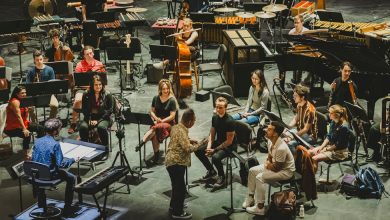Review: ‘Gnit’ Seeks Itself in a Mist of Magic and Mischief

We know the formula of the fairy tale: There is often a youth, sometimes a journey and always a touch of the fantastical to convey a moral or theme. Since we know the classic tropes from our childhood bedtime stories — don’t deviate from the path, be wary of witches, fear trolls — to contemporize a fairy tale is to shade these narrative standbys, coloring in the context of the time, updating the tone and plot to challenge our expectations.
In 1867 Henrik Ibsen did just that, putting his own experimental, modernist spin on the Norwegian story of Peer Gynt to create a timeless narrative of self-discovery — in the form of a five-act play in verse, no less. In Ibsen’s “Peer Gynt,” the title character is a lazy, selfish liar who is a headache to his poor, sick mother. When he goes to a wedding to steal away the bride — an old flame — only to fall instantly in love with another woman at the wedding, the town turns against him for his troublemaking. So he flees, and his meanderings lead him to odd characters and even odder situations — encounters with magical beings, thieves and asylum patients.
The playwright Will Eno puts his own stamp on Ibsen’s version in “Gnit,” which opened at the Polonsky Shakespeare Center in Brooklyn on Sunday night. Portraying the protagonist as a listless young man on a search for self, Eno ends up with a funny story that is myopic in scope — a self-aware and sometimes cloyingly precocious thought experiment in individualism and identity.
In “Gnit,” which originally premiered in the Actors Theater of Louisville in 2013, Eno translates Peer Gynt to Peter Gnit (that’s pronounced “Guh-nit”; you’re welcome) and consolidates many of the other characters so that a cast of six can represent a whole town. That’s one of the tricky parts of Ibsen’s text — the long list of characters, the insistent verse, the constant setting shifts, the frequent and abrupt dips into the absurd and surreal.
Eno’s text takes a route of calculated whimsy: Ibsen’s trolls are changed to real estate agents, characters make knowing references to the original story and the dialogue is tuned to a cheeky deadpan. Playing off Eno’s heightened sense of language and pacing, Oliver Butler opts for comically stylized direction in this production by the Theater for a New Audience. The actors’ movement and intonation are stiff and curiously robotic, and the lines move with the rapid Ping-Pong tempo of the dialogue in an episode of “Gilmore Girls.”
“I’m on a journey to discover, to uncover, the authentic self,” Peter tells his mother.
Her stone-dry response: “Yeah? Get some milk while you’re out.” Which isn’t to say it’s not funny — in fact, the work is genuinely hilarious, the turns are unpredictable and the performers, especially the priceless Deborah Hedwall as Mother Gynt, Jordan Bellow as several different characters, and of course Joe Curnuttein the lead role, seem to effortlessly hit their cues. (David Shih, who plays various townspeople at once, and spends most of the show in conversation with himself like a mini one-man show within the show, struggles to convey the multitude of tones and personalities and accents, and the novelty of the joke quickly wears off.)
But Eno’s self-consciously idiosyncratic, academic style eventually gets old somewhere between the nuptial kidnapping and a trip to Egypt. Offbeat, Beckett-esque ruminations and existential querying are common in Eno’s works — including the poignant “Wakey, Wakey” and his popular Pulitzer Prize finalist, “Thom Pain (based on nothing).” So his adaptation brings out the big-picture questions Ibsen had in his original, about the ways we form, and own up to, our “authentic self.” Eno’s narrow and incessant philosophizing, however, quickly limits the play from exploring other themes that may have otherwise proved more fruitful.
Ibsen’s incarnation of the fairy tale, for example, also works as a social satire of a community set at odds with its individuals and that emphasizes status over human empathy. Though the skeleton of that satire is visible in Eno’s version, “Gnit” does little to examine or expand it from Ibsen’s time to the present. Likewise, there could be a dissection of gender, a critique of class hierarchies, a sendup of this genre of storytelling itself.
There’s magic in Kimie Nishikawa’s set of verdant rolling hills with a valley in the center, and periodically the facades of little cottages descend from the ceiling. Nishikawa’s hills, which the cast members travel among, through and around as they enter and exit scenes, draw the eyes to the pastoral scene and also provide a sense of Peter’s extensive journeying.
This isn’t Norway, though. And it doesn’t seem to be the 19th century either. In fact, everything about the setting and characters is vague, which leads us yet again to the question of what Eno is trying to achieve with his adaptation?
“There is a limit to the magic powers of language,” Peter says as he tells a story to his dying mother. The lesson, that cleverness can fail when wordplay and chin-stroking ruminations distract, is one that Eno himself could have taken to heart. “Gnit” is brainy and full of rhetorical magic, but with more dimension and greater relevance it could be spellbinding.
Gnit
ThroughNov. 21 at the Theater for a New Audience, Brooklyn; tfana.org. Running time: 2 hours 15 minutes.




